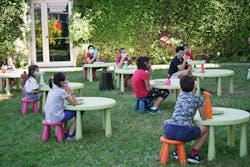At least one silver lining emerged from the dark cloud that was the Covid-19 pandemic: Striving to keep students engaged in learning, many schools decided to bring instruction outdoors to a safer space where the abundant fresh air reduced the chances that people would contract the virus.
In 2025, the Covid threat has diminished, but the benefits of outdoor learning have persuaded many schools to establish outdoor classrooms or maintain and expand the ones they relied on during the pandemic.
OutdoorClassrooms.com, an advocate for creating outdoor school spaces that are effective learning environments, points to research indicating that outdoor learning improves students’ cognitive development and critical thinking skills; physical health and activity levels; emotional well-being; and social interaction and teamwork.
"Children exposed to outdoor learning often show higher engagement levels, better academic outcomes, and an enhanced appreciation for the environment," the website says.
Picking a spot
Outdoor classrooms can take many forms, “from a well-developed structure to a few stumps in a garden,” the Green Building Alliance says. Here are some factors to consider:
*Find an adequate space for building an outdoor classroom. How accessible is the terrain for all students? What important features are nearby? How much greenery exists in the space and what can be added?
*Create boundaries for the classroom. They help keep students safe and reinforce that outdoor spaces are still classrooms.
*Set up the outdoor space so students know where to sit, walk and engage with the room. There should be a certain area where a teacher can organize the students, give assignments, and reconvene at the end of a lesson.
Oufitting the space
Comfortable, weatherproof, and adaptable outdoor classroom seating is critical, OutdoorClassrooms.com says. That can include wooden benches, stumps or log stools; five-gallon buckets, recycled plastic seating sets; folding chairs or other portable seating that accommodate flexible setups.
Installing outdoor chalkboards helps maintain the traditional elements of a classroom while encouraging creativity and interaction. These blackboards should be weather-resistant and strategically placed to facilitate group activities and lessons, OutdoorClassrooms.com says.
Integrating trees, sensory gardens, and natural play features enhances the sensory and educational experience for students. Living landscapes can serve as teaching tools for biology, ecology, and environmental stewardship.
Planners should take into account the weather conditions that may affect outdoor learning opportunities. Having sheltered pavilions and canopies will help shield students and materials from inclement weather. Installing shade sails will protect students from the harsh rays of direct sunlight.
Urban gardens
The Green Building Alliance notes that urban school may find it difficult to identify sufficient outdoor space for a classroom; in those cases, schools should seek out activities that can be done outdoors even if there is no designated classroom.
The District of Columbia Office of the State Superintendent of Education has design guidelines for campuses establishing outdoor classrooms and the gardens where outdoor classrooms are situated. Such a classroom should be "a well-defined shade space that includes workstations where teachers can easily engage with each student."
"The outdoor classrooms should be located within the school garden in a well-used and highly visible part of the school grounds that is easily accessible for students and teachers," the DC office says. "Consider environmental factors, including noise, fumes from passing vehicles, sunlight, and slope; it should articulate with existing or planned natural wildlife habitat areas."
An outdoor classroom should be built with natural materials, the office says. Use of concrete should be limited to high-traffic areas. IF hardscape is required, permeable paving or local stone (that is too heavy ot throw) is encouraged.
"Pressure treated wood, plywood, plastic lumber with wood fibers, and tires are strongly discouraged," the DC office says. "These products contain toxins that leach into water at dangerous levels. "
An outdoor whiteboard is desirable, the DC office says, and seating should accommodate up to 35 students. A teacher demonstration table and student workspaces should be available--if not permanently on site, they should be esily portable and kept in a storage shed or nearby in the school.
An outdoor classroom should be designed for low maintenance, the DC office says. Planting beds, pollinator garden areas and habitat areas must be clearly differentiated from lawn areas that require mowing in order to avoid having native plants mistaken for weeds and mowed.
About the Author
Mike Kennedy
Senior Editor
Mike Kennedy has been writing about education for American School & University since 1999. He also has reported on schools and other topics for The Chicago Tribune, The Kansas City Star, The Kansas City Times and City News Bureau of Chicago. He is a graduate of Michigan State University.

